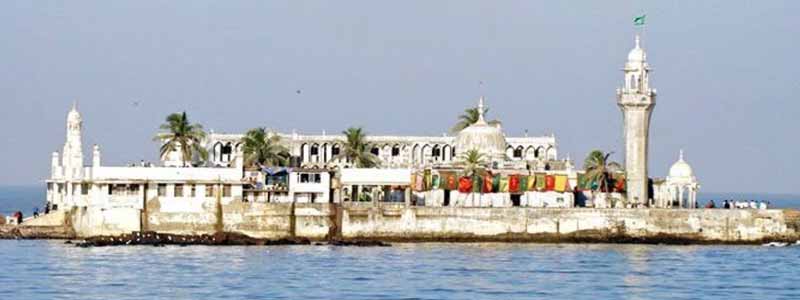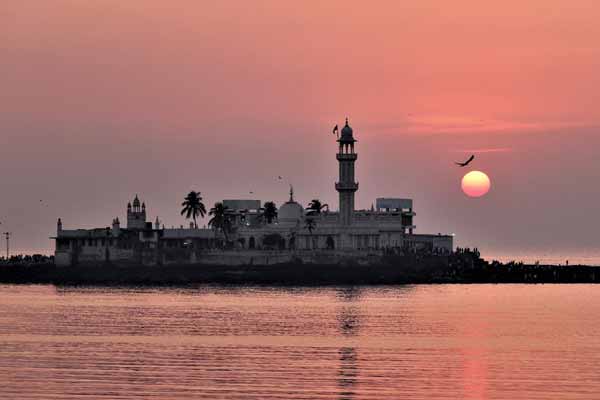Haji Ali Dargah Mumbai is a revered religious site and one of the most iconic landmarks in the city. Situated on a tiny islet off the coast of Worli, this stunning mosque and tomb complex is dedicated to the memory of the Muslim saint, Pir Haji Ali Shah Bukhari.
The structure dates back to the 15th century and is renowned for its Indo-Islamic architecture, showcasing a blend of Indian and Arabian design elements. The white domes and minarets of the dargah stand out against the backdrop of the Arabian Sea, creating a picturesque sight that draws both pilgrims and tourists alike.
One of the striking features of the Haji Ali Dargah is its location—a causeway connects the mainland to the islet, accessible only during low tide. This path, flanked by the sea on both sides, offers a unique and spiritual journey for visitors as they walk towards the dargah Mumbai Tour Packages.
Upon entering, visitors are enveloped in a serene atmosphere filled with the scent of incense and the sound of devotional songs. The tomb of Saint Haji Ali is enshrined in the center of the complex, adorned with exquisite marble and mirror work, and attracts people of all faiths who come to seek blessings, solace, and fulfillment of their wishes.
The dargah hosts various cultural events and qawwalis (Sufi devotional music) on Thursdays and Fridays, which further enhances its spiritual ambiance. Its significance as a symbol of religious harmony and unity has made it a symbol of Mumbai’s multicultural ethos.
The Haji Ali Dargah Mumbai stands as a testimony to spiritual inclusivity, drawing devotees and tourists from different corners of the world who seek spirituality, solace, and a glimpse into the rich cultural tapestry of India.

History of Haji Ali Dargah
The Haji Ali Dargah is a prominent historical landmark situated in Mumbai, India. This revered Islamic site holds religious significance and is visited by people of various faiths. The dargah, or shrine, is dedicated to Saint Pir Haji Ali Shah Bukhari, a wealthy merchant turned Muslim Sufi saint who gave up his material possessions to lead a pious and ascetic life.
The history of the Haji Ali Dargah Mumbai dates back to the 15th century when Haji Ali, originally from Bukhara (in present-day Uzbekistan), traveled to India to spread the teachings of Islam. He eventually settled in Mumbai and spent his days in meditation and serving the poor and needy.
Legend has it that before his death, Haji Ali requested his followers to bury his body at the place where he would take his last breath. Surprisingly, after his death, his coffin floated from the burial site out into the Arabian Sea, eventually coming to a halt at the location where the Dargah now stands. This miraculous event led to the construction of the shrine as a tribute to the saint, Mumbai Tourism.
The architecture of the Haji Ali Dargah is a blend of Indo-Islamic styles, featuring whitewashed domes and minarets adorned with exquisite marble and mirror work. The pathway leading to the shrine is a long causeway that gets submerged during high tide, creating a mystical and ethereal experience for visitors.
Throughout the years, the Dargah has been a symbol of religious harmony, attracting devotees from diverse backgrounds who come seeking blessings, solace, and fulfillment of their wishes. The annual Urs, commemorating the saint’s death anniversary, is a grand celebration drawing devotees and pilgrims from far and wide to pay their respects and seek blessings at this revered site.
Tourist Attractions near Haji Ali Dargah
Near the Haji Ali Dargah Mumbai, there are several attractions and places of interest that visitors often explore. Here are some notable ones:
Mahalakshmi Temple: Adjacent to Haji Ali Dargah, this temple dedicated to the goddess Mahalakshmi attracts devotees and tourists alike.
Worli Sea Face: Enjoy a scenic drive or leisurely walk along Worli Sea Face, offering a panoramic view of the Arabian Sea and the Bandra-Worli Sea Link.
Marine Drive: Popularly known as the Queen’s Necklace due to its crescent shape and sparkling city lights resembling a string of pearls at night, Marine Drive is a must-visit promenade.
Nehru Planetarium: Learn about astronomy and space at the Nehru Planetarium, offering educational shows and exhibits for visitors of all ages.
Mani Bhavan Gandhi Museum: Delve into the life and times of Mahatma Gandhi at this museum, which was his Mumbai residence and now showcases his belongings and contributions to India’s freedom struggle.
Taraporewala Aquarium: Located in South Mumbai, this aquarium houses a diverse range of marine life and is a great place for families and marine enthusiasts.
Hanging Gardens: Situated atop Malabar Hill, these terraced gardens offer a serene escape with well-manicured lawns, colorful flower beds, and a stunning view of the city.
Chowpatty Beach: Famous for its bustling atmosphere, street food, and cultural events, Chowpatty Beach is an excellent spot to experience the local vibe and enjoy sunset views.
Mumbai High Court: Architecture enthusiasts may appreciate a visit to this stunning building, an excellent example of British colonial architecture in India.
Gateway of India: While a bit farther away, this iconic monument is a Mumbai landmark and a starting point for boat rides to Elephanta Caves or a leisurely stroll by the waterfront.
These attractions near Haji Ali Dargah Mumbai offer a diverse range of experiences, from cultural immersion to serene escapes and picturesque views, allowing visitors to explore Mumbai’s rich heritage and vibrant atmosphere.
Best time to visit Haji Ali Dargah
The best time to visit Haji Ali Dargah in Mumbai largely depends on individual preferences and weather conditions. However, considering Mumbai’s climate and the significance of the place, certain periods may be more favorable for a visit.
The months between October and March are generally regarded as the best time to visit Haji Ali Dargah. During this period, the weather in Mumbai is relatively pleasant with cooler temperatures, making it comfortable for sightseeing and exploring the city’s attractions, including the Dargah. The humidity levels are lower, and the days are usually sunny, providing an enjoyable experience for visitors.
Moreover, visiting during the annual Urs festival, which commemorates the death anniversary of Saint Pir Haji Ali Shah Bukhari, can be a unique and spiritually enriching experience. The Urs usually takes place in the month of Rabi’ al-Thani of the Islamic lunar calendar and attracts a large number of devotees, offering a vibrant atmosphere with special prayers, qawwalis (devotional music), and charitable activities.
However, it’s essential to note that Haji Ali Dargah receives visitors throughout the year, so if you prefer quieter times and don’t mind Mumbai’s warmer and more humid climate, other months could also be suitable for your visit Haji Ali Dargah Mumbai.
How to Reach Haji Ali Dargah
Reaching Haji Ali Dargah in Mumbai is relatively easy due to the city’s well-connected transportation network. Here are various ways to reach the dargah:
By Road: Taxis, auto-rickshaws, and app-based cab services like Uber and Ola are readily available throughout Mumbai. You can simply input “Haji Ali Dargah” as your destination and reach there conveniently. Several buses also operate within the city, and you can find routes that pass by or are close to the dargah.
Local Trains: The nearest local train stations to Haji Ali Dargah are Mahalakshmi Station (Western Line) and Grant Road Station (Western Line). From these stations, you can take a taxi, auto-rickshaw, or a short bus ride to reach the dargah.
Private Vehicles: If you’re driving, you can reach Haji Ali Dargah Mumbai by following the roads leading to Mahalakshmi Temple. Limited parking is available nearby, but it might be challenging to find space during peak hours or on special occasions.
Walking: Depending on where you’re staying in Mumbai, walking to Haji Ali Dargah might be feasible if you’re in the nearby areas of Worli, Mahalakshmi, or Peddar Road. The dargah is located on the coast, accessible by a causeway.
Remember, the pathway to the dargah is a causeway that gets submerged during high tide, so check the tide timings before planning your visit, especially if you plan to walk.
It’s essential to note that Mumbai’s traffic can be dense during peak hours, so plan your visit accordingly to avoid delays. The accessibility options provide flexibility for visitors to choose the mode of transportation that suits them best while visiting the Haji Ali Dargah Mumbai.
